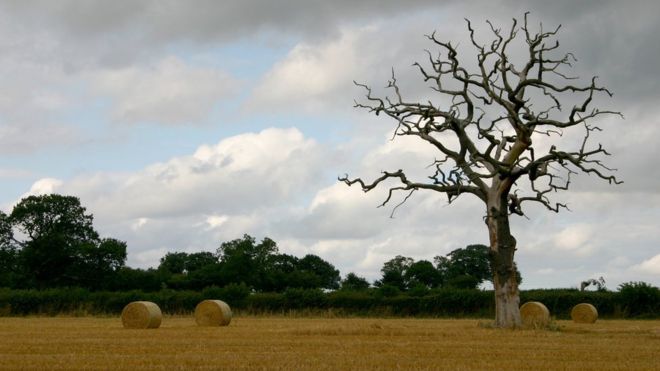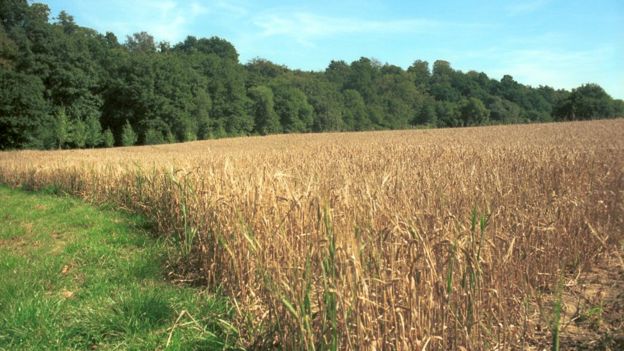Source: bbc.com
Published: January 5, 2016

Increasing agricultural yields coupled with tree planting and wetland restoration could help the UK farming industry to cut its carbon footprint
By Mark Kinver
Increasing yields produced in UK fields and using the spare farmland to plant trees and restore wetlands could greatly reduce emissions, says a study.
Combining this approach with strategies to cut food waste and meat consumption could help the farming sector cut its emissions by 80% by 2050, it adds.
Crop and livestock agriculture accounts for about 9% of the UK’s annual greenhouse gas emissions.
Details have been published in the journal Nature Climate Change.
The study suggested that increasing yields would free up land currently used for growing crops and rearing livestock.
The researchers added that if this “spare land” was used to increase UK tree cover from 12% to 30% by the middle of this century and to restore 700,000 hectares of wet peatland, it would help the farming sector to deliver its contribution to the legally binding target of cutting carbon emissions by 80% from 1990 levels by 2050.
“Every sector has to lower its emissions – that’s a commitment outlined in law and part of what we signed up to in Paris last month,” said co-author Andrew Balmford, professor of conservation science at the University of Cambridge.
“Agriculture is no exception yet a report published in 2011 that looked at how farming could be made more efficient found that there was very little room for manoeuvre.”
‘Land sparing’
So the study asked a question from a “different point of view” and considered how much agriculture was able to boost its yield by using available or soon-to-be-available technologies,” he said.
He explained that the increased yield would result in “land sparing”.
“Land sparing is a concept based on how much land we need to use for agriculture depends on the yield, how much we are producing per unit area of land,” Prof Balmford told BBC News.
“The higher the yield, the less area we have to devote to farming to meet a given level of demand.
“If we pursued higher yields as one of the primary goals in agriculture then we could free up quite a lot of land for other uses, including – in this case- greenhouse gas storage. But the key is not just to have high-yield farming but linking that to commitments or restore or safeguard remaining natural habitats.”

A growing population will increase demand for food and will increase the pressure for more farmland unless crop yields increase
In order to improve yields, the study did take into account that there would have to be higher inputs such as fertilisers and irrigation, he explained.
“We consulted a broad spectrum of experts across crop and livestock science, asking them to envisage what they considered to be feasible, They do include in many cases greater inputs per unit area but actually lower inputs per unit of production,” the Cambridge University professor said.
Prof Balmford added that the study showed that areas showing the most promise were “improved crop plants” that were more efficient at capturing nutrients from the soil, more efficient at using water and photosynthesising.
“So if we went down the high yield route then it would be possible to say that some avenues will deliver on-farm savings in terms of emissions but the greatest part of the saving will come from the fact that the footprint needed to produce that food will be considerably reduced.
“Our models suggest that if we achieved the upper reaches of high-yield production then that would result in 30-40% of land currently being used for food production being used for carbon storage.”
Biodiversity benefits
But the study also said that when it came to planting trees to sequester the carbon, it said it was not looking at vast monocultures of fast growing conifers. Instead, it considered mixed broadleaf woodlands.
“We have done a bit of sensitivity analysis to look at what it would mean if we went for the fastest growing species or if we went for very heavily managed woodlands with lots of coppicing,” Prof Balmford observed.
“Those approaches do improve carbon storage levels but by not very much, whereas restoring native woodlands would be much better for biodiversity.
“This study does not go into much detail on that but we are doing other work looking at this and there are definite biodiversity gains from this approach.”
